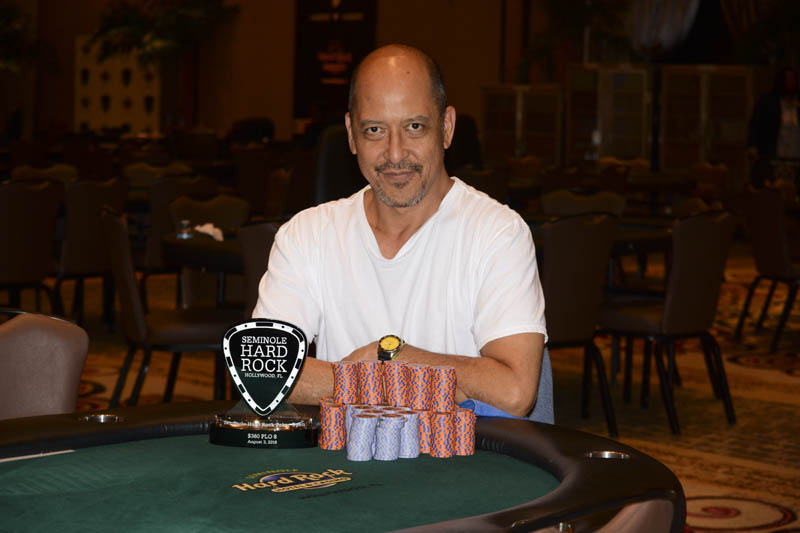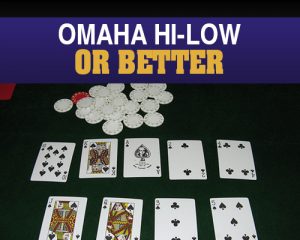How To Play Pot Limit Omaha Hi Lo
Omaha Hi-Lo is the ‘split pot’ version of the increasingly popular Omaha Poker, it can be played with many betting types (Pot-Limit / Fixed Limit or No-Limit) and is an enjoyable (and profitable!) game in both cash game and tournament format. You will see this version of Omaha called many names. The full title is Omaha High-Low Split 8 Or Better, however this is usually shortened to Omaha Hi-Lo or Omaha 8 or Better. You may also see PLO8 – this refers to the Pot-Limit betting version of the game.
Pot-Limit game – in Pot Limit Texas Hold’em, a player can bet any amount from the minimum bet to the size of the pot; No-Limit game – in No Limit Texas Hold 'em, a player can bet any amount from the minimum bet to the maximum number of chips they have in front of them. 5 Card Omaha and 5 Card Omaha Hi/Lo are similar in some ways to regular Omaha games, but with a fifth hole card dealt to each player pre-flop. 5 Card Omaha games are available at pot limit and no limit tables, while Hi/Lo games can be played at Limit, pot Limit and no Limit tables.
This article provides a simple guide to the rules of how to play Omaha Hi-Lo by running through the play of a hand from before the cards are dealt through to assessing the winning hands at the end. A basic familiarity with poker hand ranks, terms such as ‘the flop’ and ‘blinds’ are assumed.
- In Limit Omaha Hi/Lo, up to four bets are allowed per player during each betting round. This includes a (1) bet, (2) raise, (3) re-raise, and (4) cap (final raise). Pot Limit Omaha Hi/Lo The minimum bet in Pot Limit Omaha Hi/Lo is the same as the size of the big blind, but players can always bet up to the size of the pot.
- Omaha Hi-Lo, also known as Omaha High-Low, O8 and Omaha 8-or-Better, is one of the most popular and entertaining forms of poker in the world.If you’ve played Omaha High or Pot-Limit Omaha before, Omaha Hi-Lo is played according to almost identical rules.
The key factor in Omaha Hi-Lo is that the pot is split at showdown between the highest poker hand and the ‘lowest’ poker hand. To qualify for a low hand players must have 5 different cards ranked 8 or below, 2 from their own hand and 3 from the board. The best low hand being that with 5 different ‘smallest’ cards – the best possible is A-2-3-4-5.
In Omaha Poker each player is dealt 4 cards before the flop. At the end of the hand 2 (and only 2) cards from an individuals hand, together with 3 cards from the board, will be used to assess the best hand. In Omaha Hi-Lo the highest poker hand and the low hand are assessed independently… while you must use the 2 (hand) and 3 (board) card combination for each hand, the fact that they are assessed separately means that you can use one or more of the same cards for each hand – aces are the best example here.
An Example Of Determining Best Hands Using 2 and 3 Rule
Your Hand: A-2-5-K
The Flop: A-3-7-K-9
Best Low Using 2 From Your Hand And 3 From The Board = A-2-3-5-7 (ace-three-seven from the board + two-five from your hand)
Best High Using 2 From Your Hand And 3 From The Board = A-A-K-K-9 (ace-king from your hand makes 2 pair with ace-king from the board with the 9 kicker)
Blinds are posted in the same way as in Holdem poker before the cards are dealt in Omaha 8 or better. The player to the left of the dealer position posts a ‘small blind’ and the next playerleft a ‘big blind’. Each player is then dealt 4 cards face-down (visible only to the individual). The player left of the big blind will then start the action for the pre-flop betting round by folding, calling (matching the amount of the big blind) or raising.
How much can be raised will depend on the betting rules being used, here we will assume a fixed betting structure – noting differences for pot-limit and no-limit betting at the end of the article. A raise here will be twice the big blind, any additional raises are in the same increments. For example in a $1 / $2 game the initial raise is to $4, the next raise to $6 and so on – there are a maximum of 4 raises per betting round.
Once each player has either folded or matched the last raise made the flop is dealt. This comprises 3 cards dealt face-up in the centre of the table. Since at the end of the hand each player must use 2 of their own cards and 3 cards from the ‘board’ the flop will give an idea of the potential strength of hands and help you to decide whether to continue with the hand.
A second betting round then commences, starting with the first player still involved in the hand to the left of the dealer position. Once complete a 4th community card (the turn) is dealt followed by another round of betting. As in many fixed limit games the betting limits are doubled once the turn is dealt – in this example the minimum bet and raise is now $4, again there are a maximum of 4 raises allowed. The final community card (the river) is dealt next followed by a final round of betting.
Once the final round of betting is concluded players still in the hand must show down their cards to determine who wins both the high and the low sides of the pot. The golden rule (as in all Omaha games) is: “2 from your hand and 3 from the board”
No other variations are allowed! If there are 3 different cards 8 or lower on the community card board then a low hand is possible, this is assessed independently of the high hand. Players with 5 different cards 8 or lower qualify for the low, the lowest hand winning half of the pot. The highest poker hand will then be awarded the ‘high’ side of the pot.
It is possible (and indeed common) that 2 players share the low side of the pot. For example if the community cards are 4-5-7-K-K and 2 players both hold A-2-X-X (where X = high cards) then both players have made the best possible low of A-2-4-5-7. In this case the low pot is divided between these 2 players, while the high side of the pot is assessed independently.
Pot-Limit is a popular betting structure for Omaha Hi-Lo. In this game the minimum bet (or raise) is the size of the big blind, while the maximum is the size of the current pot. There are no restrictions on how many raises can be made per round in this betting style, however, if 2 or more players raise the size of the pot then the chips will quickly run out. No-Limit betting is also possible for Omaha Hi-Lo, in this case players can bet up to the amount of chips they have in front of them at any point in the hand!
Both pot-limit Omaha Hi-Lo and No-limit can lead to a player running out of chips while the other players are still involved in the hand. If this is the case the pot to which the ‘all-in’ player contributed must be closed and separated. Any players who still wish to bet will then start a new pot (called a ‘side pot’) in which the all-in player has no interest. The all-in player can only win the chips in the closed pot to which they contributed at the end of the hand.
Omaha Planet Recommendation: You Can Get A Profitable Head-Start With Omaha Indicator
Make a profit while you learn with Omaha Indicator – the leading Omaha Software which supports (and is approved by) more than 150 poker sites – including the ‘majors’. Omaha Indicator has several benefits including real time and 100% accurate odds and outs information, reads and stats on your opponents and even an alert for when you have the nuts – works for both pot-limit and no-limit Omaha Hi and Hi-Lo games, and can litterally transform your game overnight. Check out the Omaha Indicator website now for details of how you can get a copy for free!
Table Of Contents

What is Omaha Hi-Lo Split-8-or-Better Poker?
If you know how to play pot-limit Omaha (or 'Omaha high'), you are well on your way to learning how to play Omaha hi-lo.

As the name suggests, Omaha hi-lo is a 'split-pot' version of Omaha poker in which players compete for both the 'high' and 'low' halves of the pot. Omaha hi-lo is usually played with fixed-limit betting and often turns up in 'mixed game' formats like H.O.R.S.E. (in which Omaha hi-lo is the 'O') or the popular 8-game mix.
You will sometimes see the game referred to simply as 'Omaha 8' or even 'O/8' or more elaborately as 'Omaha hi-lo split-pot-8-or-better.' The name gets styled differently, too, as 'Omaha High-Low,' 'Omaha poker high-low' and so on.
Pot-limit and no-limit versions of Omaha hi-lo are also popular, especially online either as cash games or tournaments.
How to Play Omaha Hi-Lo Split-8-or-Better Poker
The basic rules for Omaha hi-lo are very similar to pot-limit Omaha. See 'How to Play Omaha Poker' for an overview of how to play Omaha poker, which is itself a variation on regular Texas hold'em.
Just like in pot-limit Omaha, players are dealt four cards in Omaha hi-lo and are required to use two of those four cards in combination with three community cards in order to make a five-card poker hand.
As in hold'em or pot-limit Omaha, if a player bets and everyone folds before the showdown, the player wins the pot without having to show a hand. However, if the final bet is called and there is a showdown, hands are examined to see who has the best 'high' hand and who has the best 'low' hand, with each winning one-half of the pot.
Omaha Hi-Lo Split-8-or-Better Rules
In Omaha hi-lo, the 'high' hand is determined exactly the same way as in hold'em or Omaha 'high' games (like PLO), following traditional hand rankings.
The 'low' hand requires a little more explanation, especially if you are new to split-pot games or hi-lo poker.
What Is Pot Limit Omaha Hi/lo
First of all, whatever cards you use to make your high hand, that makes no difference when making your low hand. You can use the same two cards, the other two cards, or any combination just as long as you use two cards from your four-card hand plus three of the community cards to build your five-card poker hand.
The rules of Omaha hi-lo is usually played with a 'qualifier' for the low hand, meaning all of the cards making up a low hand have to be ranked eight or lower. That's where the 'split-8-or-better' comes from, a phrase usually added to the name of the game.
A qualifying low hand consists of five unpaired cards ranked eight or lower. For the low hand, the ace is considered a low card (the lowest), while it can also serve as the highest-ranking card in high hands.
Also worth noting — if your lowest five cards make a straight or a flush, that doesn't matter in Omaha hi-lo, you've still got a low hand (if all are ranked eight or lower). In other 'lowball' games like 2-7 no-limit triple draw, flushes and straights hurt you by making your low hand higher, but in Omaha hi-lo that is not the case.
That means a hand consisting of 5-4-3-2-A would be the lowest possible hand — that is to say, the best 'low hand' in Omaha hi-lo. This hand is sometimes called a 'wheel.' The next lowest possible hand is 6-4-3-2-A. The worst low hand that qualifies as a low in Omaha hi-lo would be 8-7-6-5-4.
A good way to figure out which low hand is best is to arrange the hand from highest card to lowest card and then to think of the hand as a five-digit number, with the lowest number being the best (or lowest) hand. Thus 5-4-3-2-A (54321) is better than 6-4-3-2-A (64321), and 6-4-3-2-A is better than 6-5-3-2-A (65321) and so on.

An Example of an Omaha Hi-Lo Split-8-or-Better Poker Hand
Let's say a hand of Omaha hi-lo goes to showdown with the final board reading 6♣3♠K♦Q♦.
You hold A♣K♠7♦4♣, and your opponent has Q♠J♦4♦2♠.
Your best possible high hand is two pair, aces and kings — using the A♣ and K♠ in your hand pairing them with the ace and king on board, with the queen being a kicker.
Your best possible low hand is 7-6-4-3-A — using the 7♦ and 4♣ in your hand along with the three low cards on the board. Note how you can't use the ace in your hand when making your low hand, since you have to use exactly two cards in your hand and three on the board (and there is an ace on the board).
Your opponent, meanwhile, has you beat both for the high and the low!
Your opponent's best possible high hand is a flush — using the two diamonds in his hand (J♦ and 4♦) and the three diamonds on the board.
Your opponent's best possible low hand is 6-4-3-2-A — using the 4♦ and the 2♠ in his hand along with the three low cards on the board. 64321 is lower than 76431, so your opponent has you beat.

Winning both halves of the pot like this is called a 'scoop' or 'scooping,' which is something you always want to try to do when playing split-pot or hi-lo poker games.
Sometimes in Omaha hi-lo there is no qualifying low hand. This is the case whenever there are less than three unpaired cards ranked eight or lower on the board.
For example, if the board is 9♣K♦A♥4♥J♠, there are only two cards ranked eight or lower on the board (the ace and four), which means it is impossible for anyone to make a low hand. When that happens, whoever has the best high hand scoops the whole pot.
Conclusion
Omaha hi-lo is not difficult to learn, especially if you already know how to play pot-limit Omaha. The strategy can be complicated, though, with a great deal of importance placed on understanding what are strong starting hands (e.g., hands containing an ace with at least one or two low cards, especially a deuce) and not making the mistake of battling for only half of the pot (just the high or low).
Must Have Rooms
Home to the biggest tournaments online, these rooms also have the largest player base, great bonuses, tons of action and the best software. If you don't have accounts here, you are missing out on the best that online poker has to offer.
partypokerplatinum
Play Omaha Hi Lo For Free
Up to $30 of Free Play
RATING
9.9 ★
Key features
- Excellent mobile poker games
- Lots of free and real-money action
- One of the most trusted brands in online gaming